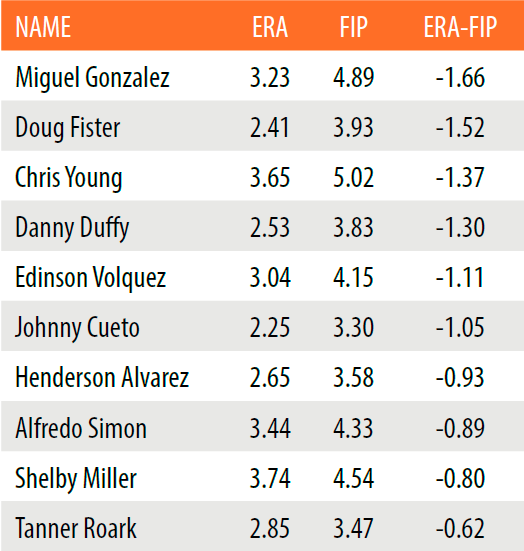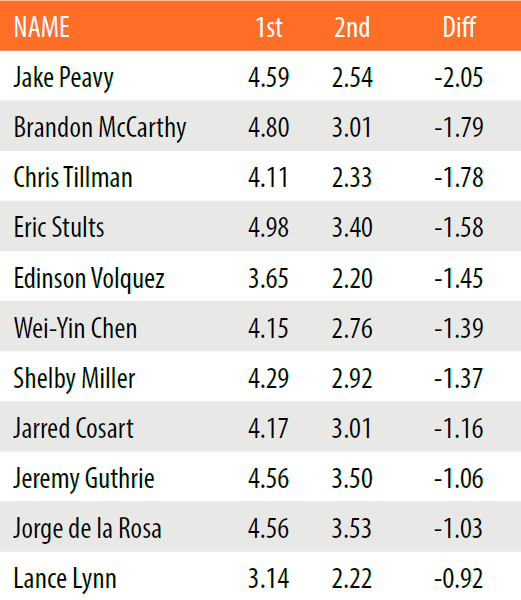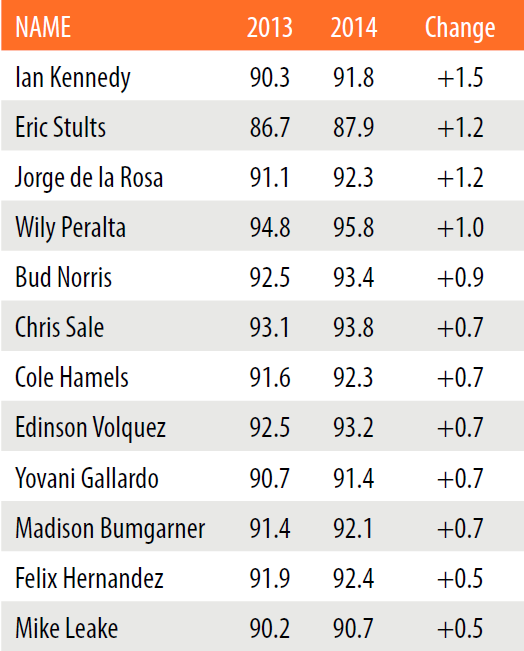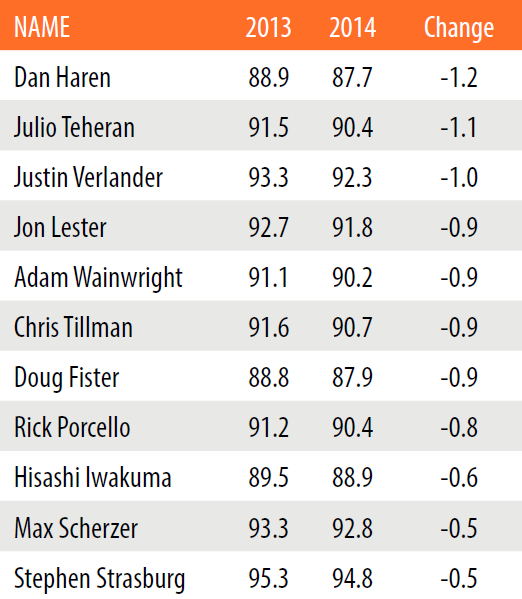This article is part of our Regan's Rumblings series.
I have been doing this long enough to come to the conclusion that what looks and sounds good on paper doesn't necessarily translate to fantasy baseball success. One example would be the famed "Verducci Effect," a theory espoused by the Sports Illustrated writer that assigns a higher level of risk to under-25 pitchers who saw a year-over-year innings increase of 30 or more.
Yordano Ventura was one candidate in 2014, but Ventura and his 97 mph fastball came through just fine (183 innings, 3.20 ERA), as did fellow candidate Sonny Gray (219 innings, 3.08 ERA). Sure, other candidates suffered injuries (Jose Fernandez the most notable), but pitchers get hurt all the time, Verducci or no Verducci.
For me though, other than past performance, there are four main things I consider when slotting my starting pitchers for my drafts:
1. Advanced Metrics
2. Youth and Upside over Safety
3. Previous Year Finish
4. Fastball Velocity
Let's take a look at each:
Advanced Metrics
When looking to set my draft board at the beginning of the year, by far my favorite method of uncovering sleepers (and busts), is to look at prior-year ERA-FIP. FIP (Fielding Independent Pitching) is a complex calculation, but essentially consists of those things that a pitcher has control over – walks, strikeouts, hit batters, and home runs. It strips out the effects of the randomness of balls in play, and when compared to a pitcher's actual ERA, it can highlight buying and selling opportunities. A significantly negative
I have been doing this long enough to come to the conclusion that what looks and sounds good on paper doesn't necessarily translate to fantasy baseball success. One example would be the famed "Verducci Effect," a theory espoused by the Sports Illustrated writer that assigns a higher level of risk to under-25 pitchers who saw a year-over-year innings increase of 30 or more.
Yordano Ventura was one candidate in 2014, but Ventura and his 97 mph fastball came through just fine (183 innings, 3.20 ERA), as did fellow candidate Sonny Gray (219 innings, 3.08 ERA). Sure, other candidates suffered injuries (Jose Fernandez the most notable), but pitchers get hurt all the time, Verducci or no Verducci.
For me though, other than past performance, there are four main things I consider when slotting my starting pitchers for my drafts:
1. Advanced Metrics
2. Youth and Upside over Safety
3. Previous Year Finish
4. Fastball Velocity
Let's take a look at each:
Advanced Metrics
When looking to set my draft board at the beginning of the year, by far my favorite method of uncovering sleepers (and busts), is to look at prior-year ERA-FIP. FIP (Fielding Independent Pitching) is a complex calculation, but essentially consists of those things that a pitcher has control over – walks, strikeouts, hit batters, and home runs. It strips out the effects of the randomness of balls in play, and when compared to a pitcher's actual ERA, it can highlight buying and selling opportunities. A significantly negative ERA-FIP could indicate that a pitcher was overly lucky and that his underlying skills portend a poor ERA the following year. Conversely, a positive number is indicative of a buy-low opportunity. Let's look at a handful of guys in each category.
Positive ERA-FIP (2014)

I can't recommend going anywhere near the likes of Correia, Nolasco, and Jackson outside of very deep leagues (even then...), but there are some interesting names on this list.
Brett Oberholtzer, Houston Astros – Oberholtzer would likely have been in the ERA-FIP table in 2013 after posting a 2.76 ERA and 3.80 FIP in 71.2 innings. A lack of strikeouts limits his upside, but an ERA slightly south of 4.00 is very possible.
Clay Buchholz, Boston Red Sox – Buchholz just needs to stay healthy, having missed significant time in two of his last five seasons and failing to reach 30 starts in any season of his career. He has considerable upside (see: 2013) if he can avoid injuries.
Phil Hughes, Minnesota Twins – It was a case of getting out of the New York pressure cooker and into relative anonymity for Hughes in Minnesota, and moving into the more pitcher-friendly confines of Target Field last year. He should improve his .336 BABIP from 2014, though it's hard to envision another 186:16 K:BB season.
Nathan Eovaldi, New York Yankees – The key for Eovaldi in 2014 was the improvement in his walk rate from 3.4 to 1.9 BB/9 year over year. He's still more a thrower (a very HARD thrower) than a pitcher, but at age-25, there's still plenty of time for him to develop his secondary offerings. The worst case could be that Eovaldi eventually becomes a dominant late-inning reliever.
Negative ERA-FIP

Johnny Cueto, Cincinnati Reds – Cueto has outperformed his FIP in each of the last six seasons, so there's no real concern here. As long as you're expecting an ERA more in the 2.50-2.75 range, you won't be disappointed.
Doug Fister, Washington Nationals – As long as his defense supports a relatively low BABIP, Fister should be fine despite a K/9 that dropped to 5.4 last year. The lack of strikeouts keep Fister from elite fantasy status, but he'll still offer plenty of value in other categories.
Alfredo Simon, Detroit Tigers – An unexpected All-Star in 2014, Simon's 5.8 K/9 limits his upside, but if he can develop his secondary stuff this spring, there's a possibility he can sustain a sub-3.50 ERA. One of the league's harder throwers with a 94 mph average fastball, Simon also has good control with a 2.6 BB/9.
Henderson Alvarez, Miami Marlins – With a 1.6 BB/9 and 2.5 GB/FB ratio, there's a lot to like here. Just 24 (he'll turn 25 in April), Alvarez has plenty of time to improve on his mediocre strikeout rate (5.3 K/9 in 2014). At worst, he looks to be a young Derek Lowe.
Danny Duffy, Kansas City Royals – Shoulder issues limited Duffy to 149.1 innings, continuing his propensity for arm injuries that already includes 2012 Tommy John surgery. His control came back for the most part last year (3.2 BB/9), and given the upside that Duffy showed as a prospect a few years ago, a breakout remains a possibility.
How Guys Finished
All in all, I'm putting more emphasis on what a guy did from July through September than what he accomplished in the first half. Maybe he tweaked his delivery at the All-Star break, perhaps he simply gained more confidence, or implemented a new grip on his curveball. Here are a few guys who showed solid improvement in the second half of 2014. It's no guarantee that this continues in 2015 of course, but I wouldn't bet against most of these guys:

Jake Peavy, San Francisco Giants – After a 4.72 ERA in 20 starts for Boston, Peavy posted a 2.17 mark in 12 starts for San Francisco. He's a poor bet to stay healthy this year given he's alternated 30+ start seasons with injury-riddled ones the past few years, but he's an excellent NL pitcher when healthy.
Brandon McCarthy, New York Yankees – His 200 innings in 2014 were close to 30 more than he has thrown in any previous season, and expecting him to stay healthy enough to repeat in 2015 is probably folly. That said, he's now shown he can pitch in the AL East, and he'll return to the NL West after signing a multi-year deal with the Dodgers. I'm pretty bullish on him for 2015.
Chris Tillman, Baltimore Orioles – Tillman's ERA improvement is supported by his first- and second-half strikeout and walk splits. First half: 5.6 K/9, 3.7 BB/9. Second half: 7.7 K/9, 1.8 BB/9.
Wei-Yin Chen, Baltimore Orioles – Chen can be very hittable at times, but he's a solid roster filler in deeper formats.
Shelby Miller, Atlanta Braves – Miller's K/9 dropped from 8.8 to 6.3 last year, but the Braves still seem to know how to mold young arms. He has breakout potential.
Jarred Cosart, Miami Marlins – There is some upside given his 93.6 mph average fastball, but he had just a 5.7 K/9 last year. Cosart could be an NL-only league surprise in 2015.
Jeremy Guthrie, Kansas City Royals – He's unspectacular, but there is something to be said for durability.
Jorge De La Rosa, Colorado Rockies – De La Rosa is actually better at home in Coors Field than away, making him a potential steal if he can cure his road woes.
Lance Lynn, St. Louis Cardinals – Lynn has posted three straight seasons of 15 wins and 180 strikeouts and he's just entering his prime. Highly underrated.
Speculating on Young Talent
When in doubt during your draft, I usually prefer the upside of a young player over an established veteran. Here are a few guys to keep an eye on this spring:
Tony Cingrani, Cincinnati Reds – Coming off an injury (shoulder) and with the Reds rotation a bit unsettled with several pending free agents, he will need to prove he's 100% in March.
Trevor Bauer, Cleveland Indians – Bauer's velocity was back up last year and now just needs to continue to drive down his 3.5 BB/9 to take that next step. He can do it.
Noah Syndergaard, New York Mets – He posted a 4.60 ERA in Triple-A last year, so Syndergaard is no lock to open in the Mets' rotation. A big spring could get him the nod, however.
Daniel Norris, Toronto Blue Jays – With an 11.8 K/9 and 3.1 BB/9 in the minors last year, Norris could compete for an Opening Day rotation spot.
Andrew Heaney, Los Angeles Angels – Heaney had a rocky 2014 debut, but the upside remains high even after an offseason trade to the Angels.
Julio Urias, Los Angeles Dodgers – He's just 18 years old, but ceiling is massive. Urias could debut later in 2015.
Dylan Bundy, Baltimore Orioles – Coming off Tommy John surgery, he probably opens in Double-A, but barring another injury, he'll be in Baltimore shortly.
Carlos Rodon, Chicago White Sox – The White Sox are a bit shaky at the back end of their rotation, but the front office is considering the possibility that Rodon could be broken in as a reliever in 2015 a la Chris Sale.
Alex Meyer, Minnesota Twins – Meyer turns 25 in April, so it's time. His 10.6 K/9 in Triple-A is appealing.
Fastball Velocity
You can bring up Greg Maddux all you want, but there is a reason why general managers target hard throwers over soft-tossers in the draft each year. Velocity matters. Of the 88 pitchers that qualified for the 2014 ERA title, just three threw harder than Miami's Nathan Eovaldi (95.7 mph), but Eovaldi's so-so 4.37 ERA is really the outlier. A quick and dirty analysis of the 10 hardest and 10 softest throwers in this group of 88 shows a distinct 2014 ERA advantage for the flamethrowers – 3.25 to 3.73. If I'm undecided between a couple guys, I'm going to err on the side of selecting the harder thrower.

Ian Kennedy, San Diego Padres – A dramatic drop (nearly 50%) in his home-run rate with a career-best 207 strikeouts resulted in Kennedy's best year since 2011. He's primed for a solid 2015, though a trade could result in a less-favorable pitching environment.
Chris Sale, Chicago White Sox – I still have concerns over his delivery. He's a top-five pitcher when healthy, but a strained flexor tendon in his pitching arm limited Sale to 26 starts last year.
Bud Norris, Baltimore Orioles – Norris is too inconsistent for me, but if he's traded to the NL, I like the upside – 200 strikeouts?
Edinson Volquez, Kansas City Royals – The Pirates' latest reclamation project, Volquez posted a career-best 3.04 ERA in 31 starts. He'll attempt to build off a 3.3 BB/9 that compares very favorably to his 4.5 career mark after signing with the Royals during the offseason. He'll continue to pitch in a favorable home park, but Volquez could struggle with the challenge of facing American League lineups.
Yovani Gallardo, Milwaukee Brewers – Once an apparent ace in the making, Gallardo has settled in as a solid No. 3 starter. His K/9 has dropped from a high of 9.9 in 2009 to just 6.8 last year. It's good to see the velocity back up a notch, but don't expect Gallardo to significantly outperform his draft position.
Madison Bumgarner, San Francisco Giants – There is not much else to say here. Bumgarner is my No. 2 starting pitcher behind Clayton Kershaw.
Mike Leake, Cincinnati Reds – Leake is still that guy you get for a couple bucks late in your auction. He won't hurt too much, and he won't help unless he's getting decent run support.
Here are a few guys that showed a notable loss in velocity in 2014:

Before you panic over some of these notable names, Felix Hernandez has seen his velocity steadily decrease (at least until a turnaround in 2014) from a high of 95.8 mph as a rookie in 2007 to 92.4 mph last year. That hasn't prevented him from nearly winning his second Cy Young award last year and putting up his ninth consecutive season of 30+ starts. Where King Felix has compensated for the drop in velocity is with vastly improved control and command as well as the development of what is arguably baseball's best changeup. It's fair to question whether the guys in the table above can do the same.
Here are a few pitches of particular concern:
Justin Verlander, Detroit Tigers – With five consecutive years of declining velocity and last season, Verlander's worst since 2008, he's a fallen star. He's talented enough to adjust his game and have success well into his 30s, but at age-32 this year, it's safe to say he's no longer an elite option.
Julio Teheran, Atlanta Braves – Teheran has elite control, but he doesn't miss enough bats to be targeted as a top-tier starter.
Chris Tillman, Baltimore Orioles – I'm lukewarm here. He can seem so hittable at times, and even his good starts aren't dominant. There is still room for improvement, but Tillman has the ceiling of a low-end No. 2 at best.
Rick Porcello, Boston Red Sox – The 5.7 K/9 isn't likely to improve significantly anytime soon, but Porcello is durable, he generates groundballs, and he minimizes free passes. With 2015 being his walk year, Porcello is looking at $100 million as a free agent next winter. There's something to be said for consistency in your fantasy rotation as well.
Doug Fister, Washington Nationals – With a FIP of 4.00 versus an ERA of 2.41 in 2014, Fister is likely to be overvalued in 2015 drafts. Expect his BABIP (.270 in 2014) to regress given his .300 career mark, making an ERA in the 3.25 range more likely.
This article appears in the 2015 edition of the RotoWire Fantasy Baseball Guide.










